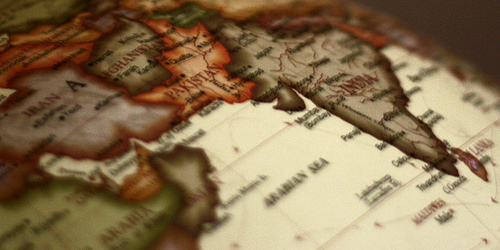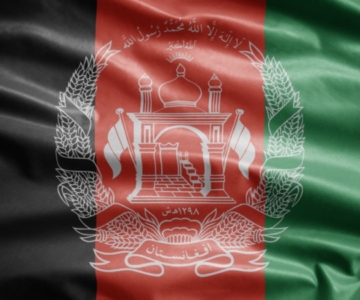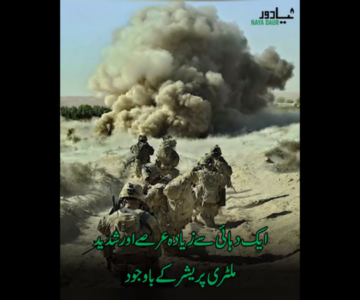Pakistan’s relationship with Afghanistan is caught in the muddled terrain of domestic political machinations and regional ambitions.
Afghanistan’s history is a turbulent one filled with civil wars, invading armies, foreign political meddling, and disputed successions. Sitting on trade routes between the Mediterranean and China, the Silk Road, and the entrance to India, it has been seen as a prize for many conquering empires. Sadly, Afghans have paid a heavy price for this curse of geography. The British Empire in the 19th century could not subjugate the territories, nor could the Soviets in the 20th. Now the US-led coalition forces, after a disastrous occupation of 12 years, plan to leave the country later this year. 2014 is not just significant for Afghanistan: it will result in regional shifts of power and a new security paradigm, with serious implications for Pakistan.
The Soviet invasion in 1979 unleashed a period of intense conflict as the US and the West responded by mobilising unprecedented resources and funnelling support to mujahideen fighters through regional proxies, most notably Pakistan. Driven by its regional ambitions and perennial fear of India, Pakistan entered the game and for a decade supported the development and oversight of a jihad industry that played on Islamist passions against the infidel Soviets. Thus, a stream of jihadists crossed the Durand Line and found many allies to further the rise of Deobandi Islam on both sides of the border. This was a defining moment when jihad acquired a legitimacy of its own and engulfed not only Afghanistan but also Pakistan.
Another reading of Pakistan’s heavy involvement during this period was driven by the long-standing demand for a greater Pashtunistan, as well as fears of expanding Soviet influence. For instance, the decision to support Islamists in Afghanistan was taken by Pakistan’s popular Prime Minister Zulfikar Ali Bhutto in 1974. Afghanistan has always disputed the international status of the current border with Pakistan (the Durand Line), while Pashtun nationalists historically demanded the merger of Pakistan’s Northwest Province (now Khyber Pakhtunkhwa) with Afghanistan.
Similarly, Afghanistan made claims on Pakistan’s territory and extended support for carving out a new state. During the 1970s, the government of General Mohammed Daoud Khan backed the Pashtunistan movement which was viewed with great suspicion by the Pakistani state. In response to this situation, Bhutto promoted the idea of supporting Islamist militants in Afghanistan as a counterweight to demands for Pashtunistan. His successor General Zia ul-Haq merely carried forward the policy with all the might of the Pakistani state, and also marshalled public opinion in its favour. Even today, the struggle of the mujahideen is revered in Pakistan and support for the Afghan Taliban is considered by some to be just and moral.
With the withdrawal of the Soviet Union, infighting began among the various factions of the mujahideen, leading to a bloody civil war and the emergence of the Taliban. Both the power vacuum and local clamour for stability aided the Taliban’s rapid rise, and by 1996 they controlled most of Afghanistan’s territory. The Taliban movement received substantial support from Pakistan, and the two are still linked despite international pressure. Indeed, since the early days of the US invasion of Afghanistan in 2001, Pakistan has been a sanctuary for Afghan Taliban insurgents. It is reported that the Taliban high command operates from secure locations in Quetta and Karachi, and the Haqqani network, a veritable arm of this movement, operates from North Waziristan. Pakistan has managed to maintain its influence in Kabul despite the overthrow of the Taliban regime.
Pakistan’s security climate is linked with the situation in Afghanistan, and continuing instability in the neighbourhood is a major concern. Pakistan’s military in the past viewed Afghanistan as its strategic backyard, calculating that in case of war with India, Pakistan’s army could withdraw into Afghanistan, regroup and then mount counter-attacks on Indian forces. Beginning in the 1990s, Pakistan’s support to the Taliban was a reflection of its pursuit of strategic depth in Afghanistan. However, the tables may have turned. Since 2007, the emergence of the Taliban movement in Pakistan in the form of Tehrik-i-Taliban Pakistan (TTP) has posed a formidable challenge to the state. Pakistan’s government is struggling to end the internal war with the TTP, and both sides are closely following the US drawdown. Pakistan’s political establishment, known for its close relations with the Taliban, has calculated that the Afghan Taliban’s bid for power after a US withdrawal will pull in certain groups of TTP, thereby reducing the level of conflict in the country.
On the other hand, the Taliban in Afghanistan and Pakistan are not likely to squander a chance to regain power. While the military and some civilian leaders remain loyal to the pursuit of gaining influence vis-a-vis arch rival India, other voices in the political sphere and civil society have been warning of disastrous consequences if Afghanistan’s Taliban were to recapture power. Potentially, TTP could move into Afghanistan, regroup, expand, then launch a new wave of attacks against Pakistani forces. Pakistan’s army is likely to face operational and strategic constraints in an offensive against TTP, and will invite condemnation and resistance if it attempts to cross the international border in pursuit of militants. TTP could find a strategic backyard in Afghanistan if the Taliban come to power, which in turn may lend support to the TTP network within Pakistan.
Strategic depth in reverse
Growing relations between India and Afghanistan have alarmed an already suspicious Pakistan, and India seems willing to take over the US role in training Afghan security forces, at least to a limited extent. India aims to expand its footprint in Afghanistan beyond development aid but is constrained by its geography. Some international observers have warned that Afghanistan could become the centre of a new proxy war between Pakistan and India. Pakistan’s past policy of strategic depth was intended to contain Indian influence in Afghanistan.
An official report prepared by the Home Department of Khyber Pakhtunkhwa, found that the Afghan Taliban enjoy strategic depth in areas of Pakistan because of the ideological, material and coordination linkages with militant networks of Pakistan. Currently, Pakistan faces a scenario in which the TTP leadership enjoys an open arena across the border in which to operate. The object of TTP is to capture or claim a share of Pakistan to create a Caliphate – the kind that al-Qaeda prescribes at the global level.
Thus, many in Pakistan believe that the US and NATO drawdown will be a victory for the Taliban as a whole. The aforementioned document, leaked to the Pakistani press, states that the Afghan Taliban will continue to provide strategic depth to Pakistan-based militants. The Taliban, inspired by a borderless ummah, consider state boundaries irrelevant. Militant Islamists are to be supported wherever they struggle. The report adds that with the departure of the US troops, the TTP and its multiple partners will pursue their jihad with renewed vigour under the banner of setting up a true Islamic Caliphate in Pakistan.
Under Taliban rule, Afghanistan allowed Pakistan’s sectarian organisations to operate bases and training facilities on Afghan soil. During his 1997-1999 tenure, current Prime Minister Nawaz Sharif attempted a crackdown on sectarian outfits only to have his government’s efforts scuttled by none other than Taliban forces and their allies in Pakistan. Escape routes were likely organised by operatives within the Pakistani establishment, particularly from powerful intelligence agencies.
Presidential elections in April represent a major part of Afghanistan’s ongoing transition period, but due to prevailing uncertainties, particularly related to security, Pakistan and other countries in the region are likely to view new developments with trepidation. The polls face several challenges, including ensuring fairness and acceptance of the results, and forging consensus among the country’s ethnic diversity. The danger of political violence is ever-present, and governance patterns are marked by nepotism, weak rule of law, exclusionary patronage networks and corruption. Elections that ensure the participation of all groups and an orderly transfer of power would do much to stabilise the country, and neutrality on the part of the US and other foreign powers is essential for the outcome to have legitimacy in the eyes of Afghans. However, serious questions hang over the elections in terms of how the Taliban will respond and whether they can be included in the political process.
This is perhaps the major threat to an orderly transition in the country. Meanwhile, as the Taliban mobilise against elections, talks between the Pakistan-based leadership of the Afghan Taliban and the governments of the US and Afghanistan are going nowhere. All parties are treating the future as a game of chess, attempting to checkmate each other rather than thinking of regional stability and the future of millions of Afghans.
Competing interests
As the US prepares to withdraw, it seeks to maintain some American soldiers as consultants and trainers in Afghanistan to support the Afghan National Army. The US has indicated its willingness to work with the winner of what it states should be free, fair and credible elections. Though the still-pending Bilateral Security Agreement could translate into the permanent presence of a smaller contingent of US forces in Afghanistan, it remains a critical denominator in the future dispensation of Afghanistan and its security prospects.
Iran is also heavily involved in Afghanistan and has cultivated political ties with many factions, especially the Shia, Farsi-speaking non-Pashtun groups. The Iranian government is content with sending economic aid for the purpose of promoting stability, thereby reducing the possibility of Afghanistan being used as a base for attacks against it. They are especially wary of Sunni militants backed by Saudi Arabia and Pakistan targeting Iranian interests and the Shia population in the region. Iran accounts for nearly 40 percent of exports to Afghanistan and around 2000 Iranian companies operate in Afghanistan. The level of bilateral trade, to the tune of USD 2 billion, has fostered a relationship based on interdependency. The return of the Taliban, and with it the isolation of the country from Iran, would be disastrous for the Afghan economy and long-term political stability.
But while the US-Iran thaw heralds a new beginning at the international level, it also has important regional implications. Though Iran may be suspicious of a continued US presence, it is keen to ensure that a full-scale Taliban regime does not assume power in Kabul. It is also interested in protecting the interests of its traditional allies, such as the Shia Hazara, the Farsiwan Heratis, and Tajiks.
The Taliban remain the proverbial elephant in the room. They will have a say in the fate of Afghanistan. This is why the US is keen to talk to them, and Afghan authorities want further dialogue with them. Both want Pakistan to facilitate this engagement. Pakistan has its own concerns about the future of the Taliban movement within its fold. Pakistan’s facilitation therefore can only be on its own terms. The chessboard is, indeed, confusing and complex.
A relatively stable Afghanistan that does not slide back into civil war and become a haven for transnational militant groups that destabilise regional neighbours, particularly Pakistan, is contingent upon a credible election that produces a legitimate successor to President Karzai. Credible elections will lay the foundation for an eventual political settlement that would take into account the interests of all regional players. But for such a political settlement, neighbouring countries have to adopt and pursue policies of non-alignment and non-interference in Afghanistan’s internal affairs.
Afghanistan has been economically dependent on Pakistan for a long time. An official trade agreement exists, but its partial implementation has led to the continuation of smuggling. In fact, powerful lobbies supported by smugglers on both sides of the border prevent concrete action on this issue, with smugglers now bit-actors in the conflict. Considering that Afghan exports and imports are mostly reliant on Karachi Port, a secure and economically developing Afghanistan represents a boon to Pakistan’s ailing economy, as it may provide a growing market for Pakistani products. If this economic climate continues to grow, Pakistani workers and companies may have greater access to lucrative reconstruction and development contracts. Also, it would allow for the enhancement of transportation links, both road and rail.
Pakistan desperately needs to access untapped markets in Central Asia, which is one of the reasons for its backing of the Taliban. Since the early 1990s, Afghanistan and Pakistan have sought to build the Turkmenistan-Afghanistan-Pakistan-India (TAPI) pipeline, which will transport Central Asian energy, particularly from Turkmenistan, to markets in Southasia. The TAPI pipeline remains unrealised to date due to insecurity, high prices demanded by the suppliers, the unreliability of Turkmenistan’s reserves, lack of adequate outside financing and continuing tensions between India and Pakistan. Furthermore, the ambitious World Bank-funded project CASA-1000, aimed at importing electricity from Central Asia to Pakistan, remains on hold due to the fragile security situation.
Future scenarios
Given the complexity and competing interests for influence in Afghanistan, what are the future prospects? The prevailing political and security situation points to four possible scenarios related to the US and NATO military withdrawal and the disengagement of the international donor community.
The first is the dreaded but not impossible prospect of the Taliban defeating a weak, desertion-prone Afghan National Army and assuming power in Kabul. This would take the country back to the situation of the 1990s. A Taliban political takeover could, in the long-run, lead to the division of Afghanistan, as forces in the north would resist the Taliban’s attempts to exercise absolute power. While violence may decrease under a totalitarian regime, this prospect would jeopardise nation-building efforts and the evolution of Afghan institutions supported by the international community.
If the US stays committed to enhancing governance and security in Afghanistan, Pakistan and other regional states, including Iran, may continue supporting different insurgent groups. These countries will vie for power through proxies to secure their regional and national security interests. The undesirable proxy war between India and Pakistan could escalate into a conventional confrontation. In the meantime, Iran, Russia, China and the Central Asian states would also manoeuvre to secure their interests by undermining the efforts of US forces.
Another possibility is that if the US withdraws while cutting political and economic support to the government in Kabul, and Pakistan continues to support the Taliban with more resources and material, Afghanistan may descend into a civil war akin to that of the 1990s. If this happened, regional countries would throw their support behind competing groups and power-brokers, and Afghanistan would become a greater source of regional instability and a threat to international security.
Finally, in an ideal scenario, India and Pakistan would bridge their trust deficit and cooperate with the international community, especially regional players such as Iran and the Central Asian states, to work for stability in Afghanistan. All parties could gain from such a settlement as Afghanistan could serve as a conduit for energy trade in a region starved of reliable sources. In this scenario Pakistan stands to gain significantly due to its geostrategic location and maritime infrastructure, allowing it to sell energy to countries further abroad. Such approaches appear rational and beneficial, but unfortunately are not likely to come to fruition given the way national interest is understood and articulated in New Delhi and Islamabad. Pakistan’s current government is keen to mend fences with India, but faces roadblocks caused by entrenched establishment elites. India will have a new government by the middle of 2014, and a rightwing coalition led by the Bharatiya Janata Party would significantly reduce the chance of détente with Pakistan.
It is therefore a test for the Afghan leadership to forge consensus and unity and demonstrate the extent to which they can resist outside map-drawers and the self-styled arbiters of their future. The international community, particularly the US, has a responsibility not to abandon the country they invaded with high rhetoric and grand ambitions. Their engagement in the years to come will be vital. At the same time, the US and NATO exit is an opportunity that cannot be squandered by regional stakeholders. History has some bitter lessons to offer, if only players such as Pakistan were willing to learn from them.



